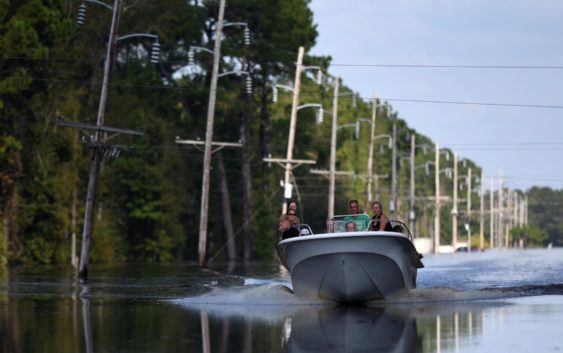- The White House's Christmas tree is a symbol of resilience for hurricane-hit North Carolina farms
- Hurricane Helene isn't the only big storm North Carolina is still recovering from
- Warm winter ahead: WRAL Severe Weather outlook doesn't look good for snow lovers
- Recovery continues for western NC nearly two months after Hurricane Helene
- Recovery continues for western NC nearly three months after Hurricane Helene
Environment still recovering from Hurricane Florence

The hurricane destroyed thousands of trees and flooded huge areas; the recovery could take years
WILMINGTON — A year later, Cape Fear Riverkeeper Kemp Burdette still finds it helpful to explain the environmental impact of Hurricane Florence using satellite images taken in the days following the historic storm that dumped more than 25 inches of rain on Southeastern North Carolina.
From his office at the Cape Fear River Watch in downtown Wilmington, he scrolls through and points out where and how the Sutton Lake dam breached, causing coal-ash byproducts to run into the lake and Cape Fear River, and where wastewater from factory farms spilled upriver and flowed into local communities.
The hurricane also brought beach erosion, fish kills, a devastating loss of local trees.
For Burdette, the impact was personal, too. His home on the Black River in Pender County flooded. But he knows that other storms are likely on their way in coming years so he’s preparing by lifting his home off its foundations.
“I had 4 feet of water and I’m raising it 8 feet,” he said.
Regaining ground
In a similar way, he, the Cape Fear River Watch (CFRW) and other local groups are helping the area recover from Florence and prepare for the next hurricane. CFRW still regularly flies over the area to monitor floods and large-scale hog and poultry farms, and they push legislative efforts that will lessen the damaging effects that storms like Florence can have on the area. This week, they made another post-Hurricane Dorian flight.
Other recovery efforts are also ongoing. Wilmington’s forestry staff only finished their hurricane response in February, and it seems the preservation of local trees has been an increasingly important. This year, more money, $50,000, was allotted to plant and maintain trees in Wilmington and next week, New Hanover County Commissioners will discuss a possible tree-protection ordinance.
Aaron Reese, the city’s forestry management supervisor, said that more than 1,500 trees were damaged and cut down in the aftermath of the hurricane, but we may not know the total extent of the damage.
“It’s hard to know what the number is for the whole area,” said Connie Parker, chair of the Alliance for Cape Fear Trees. “We were worried before, just the trees lost to development. And then Florence. It may be tens of thousands, at least. And that’s probably an underestimation.”
She also suspects that more were lost after the storm because of fear.
“People don’t always understand the value of trees,” Parker said. “And many were taken down because people were worried that they would fall on their house during the next storm.”
She said that trees can absorb thousands of gallons of stormwater, and prevent that rainfall from collecting contaminants and flooding streets, homes and parting lots. Plus, they help clean the air and contribute to our overall well being.
“They are good for the psyche,” Parker said.
Florence gone, far from forgotten: Click here for previous StarNews stories, editorials and letters about Hurricane Florence and its impact.
Reese said that while he’s already started the re-planting trees in Wilmington, there will be a larger effort this fall. That’s true for the Alliance, as well. They’ve worked with grants, nonprofits and other agencies to organize several plantings scheduled for the upcoming months, including one adding bald cypress and redbud trees at Thomas Lilly Park in Wilmington on Friday, Sept. 20.
Multiple environmental fronts
Parker notes, though, that restoring the area’s tree canopy won’t be quick. As will mitigating beach erosion that only worsens during large storm events. And recovering local fish population.
After Florence, dead fish were found in Greenfield Lake and other waterways, and along roadsides as floodwaters receded.
“Scientists are still looking at the impact on fisheries,” Burdette said. “But I’ve seen some anecdotal information that it isn’t good.”
Each spring, Cape Fear River Watch hosts StriperFest where local fishermen catch striped bass, an important indicator species in local waterways, to tag them. In previous years, they’ve tagged as many as 77 fish. This year, it was seven, Burdette said.
“I think there’s a lot we can do to help prepare for the next storm,” he said.
Among the efforts he’s pushing for more water quality sampling, are adding permit requirements for large-scale poultry farms, and tougher restrictions on hog farms.
“And we should ban building these farms in flood plains,” he said.
Parker thinks those steps could make the area more resilient, but in the meantime, the area is still susceptible to future storms.
“It will take a long time before we are back where we need to be,” she said.
Allison Ballard can be reached at 910-343-2075 or aballard@gatehousemedia.com.
Got a niche and want to be in the know? Subscribe to our free newsletters!
Update My Profile